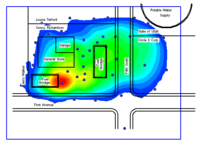GMS:Converting 2D Scatter Points to Other Types of Data
From XMS Wiki
Jump to navigationJump to search
2D scatter points may be converted to other types of data used in GMS, such as a TIN, 2D mesh nodes, or observation points. 2D scatter points are converted by using the following commands in the Scatter Points menu:
- Scatter Points → TIN
- Creates a set of TIN vertices. These vertices are automatically triangulated to form a TIN.
- Scatter Points → Mesh Nodes
- Creates a set of 2D finite element nodes from the points in the active scatter point set. Requires triangulating the nodes to create the 2D mesh.
- Scatter Points → Obs. Pts.
- Creates one observation point for each of the scatter points in the active scatter point set. The active dataset values become the measured values for the observation points. Create a coverage with a measurement before executing this command.
- Scatter Points → 3D Scatter Points
- Creates a 3D scatter point set from the 2D scatter points. All of the datasets are copied to the 3D scatter points. The Z (elevation) of the 3D scatter points is set to the Z of the 2D scatter points at the time of conversion.
Scatter points can also be converted to either a 2D grid or 3D grid by using the bounding grid commands.
- Bounding 2D Grid...
- Creates a 2D grid that bounds or contains all of the scatter points in the active set. Will launch the Create Finite Difference Grid dialog which allows defining the grid dimensions.
- Bounding 3D Grid...
- Creates a 3D grid that bounds or contains all of the scatter points in the active set. Will launch the Create Finite Difference Grid dialog which allows defining the grid dimensions.
| GMS – Groundwater Modeling System | ||
|---|---|---|
| Modules: | 2D Grid • 2D Mesh • 2D Scatter Point • 3D Grid • 3D Mesh • 3D Scatter Point • Boreholes • GIS • Map • Solid • TINs • UGrids | |
| Models: | FEFLOW • FEMWATER • HydroGeoSphere • MODAEM • MODFLOW • MODPATH • mod-PATH3DU • MT3DMS • MT3D-USGS • PEST • PHT3D • RT3D • SEAM3D • SEAWAT • SEEP2D • T-PROGS • ZONEBUDGET | |
| Aquaveo | ||
